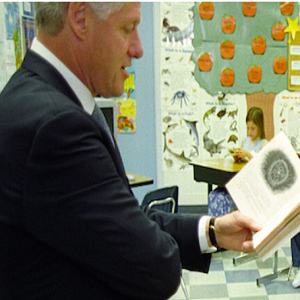William J. Clinton Presidential Library and Museum
Bill Clinton was the 42nd President of the United States, serving between 1993-2001. During his tenure as president he signed the North American Free Trade Agreement, witnessed the expansion of NATO, signed the Dayton Peace agreement to end the war in Bosnia, order the United States to intervene militarily in the Bosnian and Kosovo wars, signed the Iraq Liberation Act which aided groups against Saddam Hussein, and participated in the Oslo I Accord, the Camp David Summit under President Carter, and assisted in the Northern Ireland peace process. Since leaving office, Clinton has been involved with the Clinton Foundation and has engaged with the global HIV/AIDS epidemic, global warming, and disaster relief. His Library is located in Little Rock, Arkansas. The Library offers few educational resources, but a couple are connected to Clinton’s global legacy, both are best suited to high school students.
One of these resources is the Advise the President unit which features several presidents. The Clinton unit focuses on Clinton’s intervention in Kosovo in 1999. Though the full lesson plan is not linked on the Clinton Library site, it is available through the National Archives here. This lesson plan offers standards alignment statements, pre-made student workbooks which include instructions, primary sources, and guiding questions. All lessons come with a moderator guide for the instructor to lead their students through the experience and a document briefing packet for students. The experiences are designed to let students work either individually or on teams to read the briefing packets and act as advisors to the president, offering suggestions for a direction which the United States might take in each scenario. The packets also include a summative discussion of what the president did in each situation. Advise the President may be helpful in teaching students about the individual conflicts as well as more broadly about the presidential decision-making process, American’s role in global conflicts, and internationalism. Educators who wish to augment the experience may want to include primary source documents. Doing so may allow students to more fully simulate making these decisions as presidential advisors and may familiarize them with critical reading and thinking skills.
The other resource is Days Like This, a lesson meant to accompany an exhibit on display at the library. This unit engages with Clinton’s assistance in the Northern Ireland peace talks. The lesson offers three options, one which leads students through an arts project and focuses on diplomatic and symbolic gift giving, one which leads students through researching and evaluating past diplomatic efforts, and one which leads students through planning a presidential summit for diplomatic talks. Though these lessons are not as focused on Northern Irish history or peace, they may be useful for educators who wish to teach about the diplomatic process. Educators may wish to provide their students with background information on the Northern Ireland conflicts and other examples of presidential diplomacy.
Overall, we found that though the Clinton Library offers a few lesson plans pertinent to global history, these are a bit underdeveloped and educators wishing to use them should strongly consider using supplemental materials and offering background to their students. The lessons are less suited to teaching history than they are to teaching historical processes like presidential decision-making and diplomacy.
